Driver Airbag (DAB) Module and Clock Spring
Description and operation
| •
| Driver Airbag (DAB) DAB is installed in the steering wheel, and electrically connected to the SRSCM via clock spring. It is deployed during frontal impact to protect the driver. |
| •
| Clock Spring Clock spring delivers actuation signal, generated by the sensors installed in the front and right/left sides of a vehicle, to the inflator (gas generator) of the driver air bag module via internal cable. It also delivers actuation signal of the steering wheel remote control switch and horn to relevant systems via internal cable. |
| •
| Never attempt to measure the circuit resistance of the airbag module (squib) even if you are using the specified tester. If the circuit resistance is measured with a tester, accidental airbag deployment will result in serious personal injury. |
|
Components and components location
[Normal type]
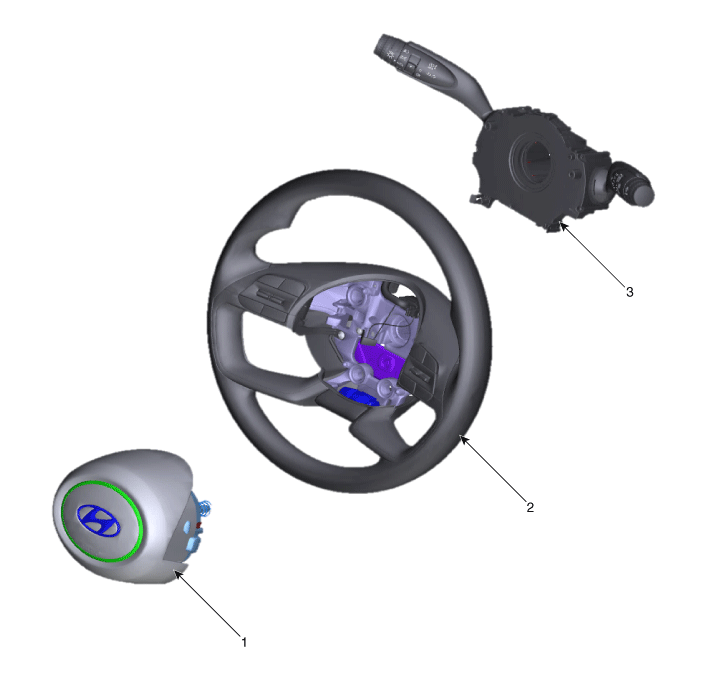
1. Driver Airbag (DAB)
2. Steering Wheel
| 3. Clock spring assembly
|
[N Line]
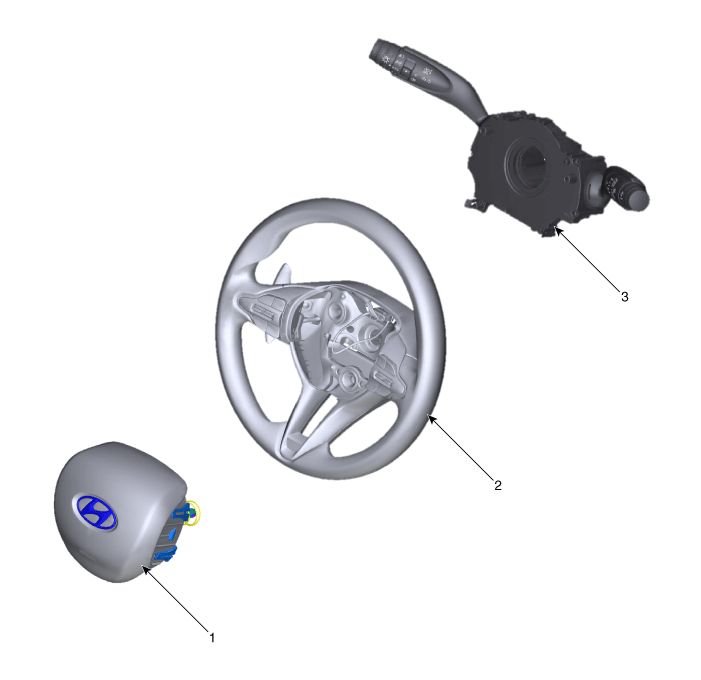
1. Driver Airbag (DAB)
2. Steering Wheel
| 3. Clock spring assembly
|
Repair procedures
Driver Airbag (DAB)
| •
| Never attempt to measure the circuit resistance of the airbag module (squib) even if you are using a specified tester. If the circuit resistance is measured with a tester, accidental airbag deployment will result in serious personal injury. |
|
| 1. | Check the airbag module for denting, cracking or deformation. |
| 2. | Check hooks and connectors for damage, terminals for deformities, and harness for binds. |
| 3. | Check airbag inflator case for dents, cracks or deformities. [Normal type] 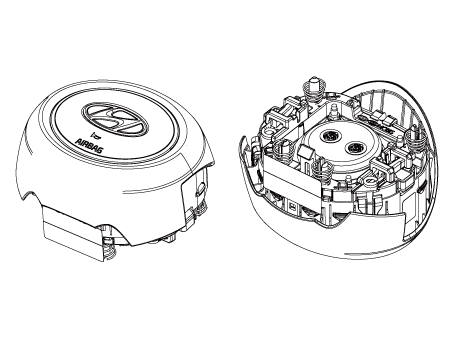
[N Line] 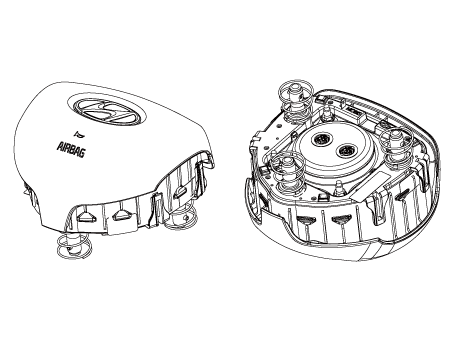
|
Clock Spring
| 1. | If any improper parts are found during inspection, replace the clock spring with a new one. |
| 2. | Check connectors and protective tube for damage, and terminals for deformities. 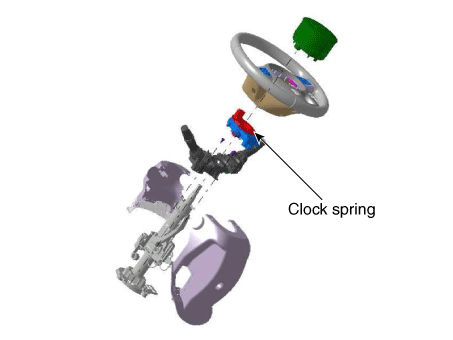
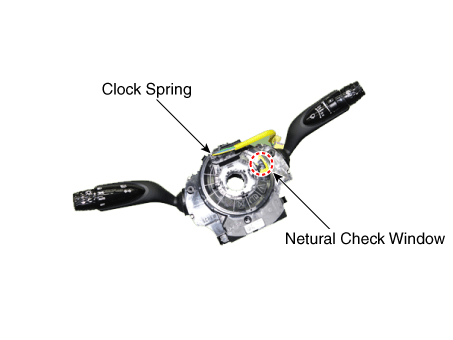
|
| 1. | Set the front tires straight-ahead. | •
| If the steering wheel is not aligned to the center position, it may cause the disconnection and/or bending of the internal cable by improper steering wheel rotation. |
|
|
| 2. | Disconnect the negative (-) battery terminal. | •
| Disconnect the battery negative cable, and wait for at least three minutes before beginning work. |
|
|
| 3. | Remove the driver airbag module. | –
| Put a flat tool into a guide hole located in the left/right of steering wheel and press a DAB fastening pin (A). |
[Normal type] 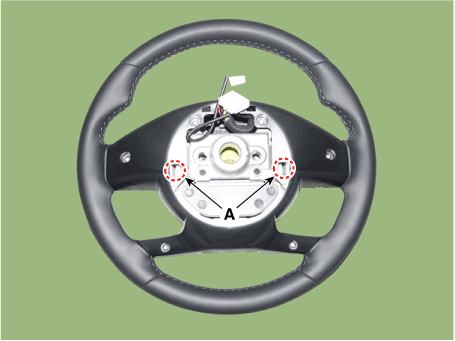
[N Line] 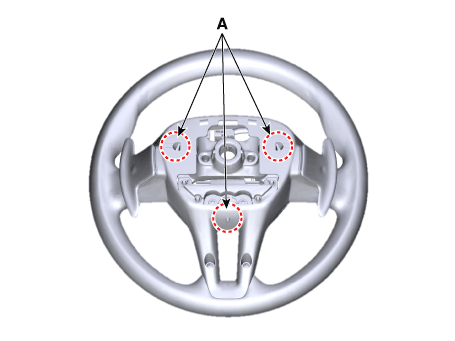
| •
| After inserting the tool, press the DAB fixed pin in the direction of the arrow as illustration below. 
|
|
|
| 4. | Remove the airbag module from the steering wheel after disconnecting the module connector (A) and horn connector (B). [Normal type] 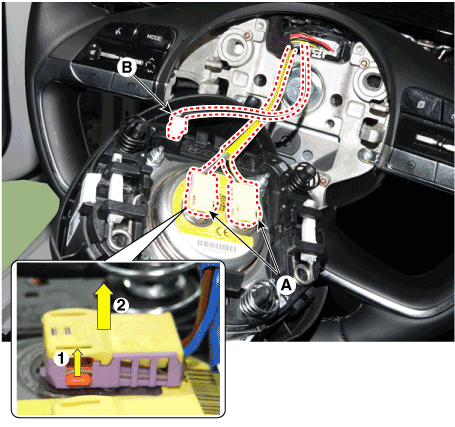
[N Line] 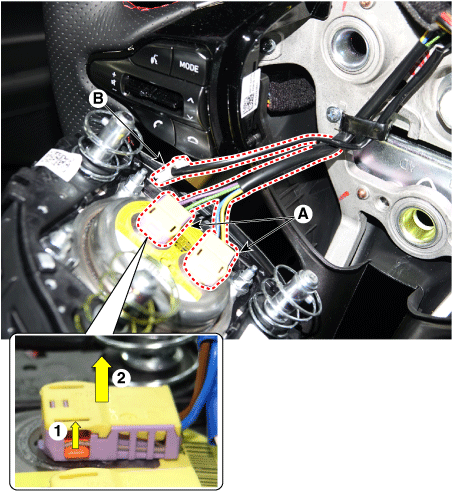
|
| 5. | Remove the steering wheel. (Refer to Steering System - "Steering Column and Shaft") |
| 6. | Loosen the steering wheel column shroud panel. (Refer to Body (Interior and Exterior) - "Steering Wheel Column Shroud Panel") |
| 7. | Press the lock pin and then separate the connectors (A). 
|
| 8. | Loosen the clamp mounting screw (A) and then remove the multifunction switch assembly (B). 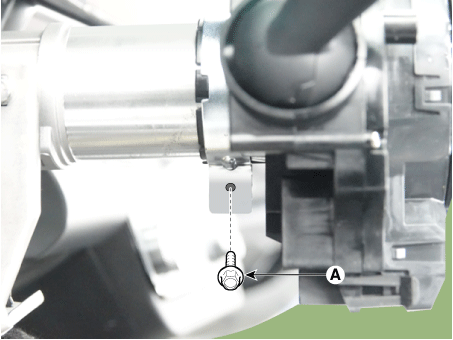
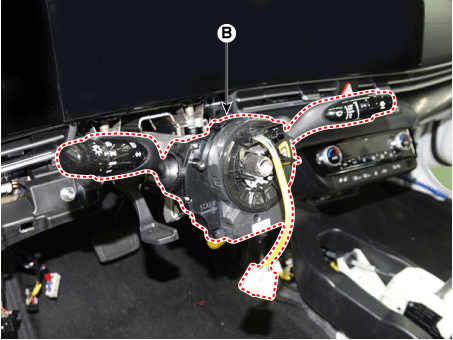
|
| 1. | Set the front tires straight-ahead. | •
| If the steering wheel is not aligned to the center position, it may cause the disconnection and/or bending of the internal cable by improper steering wheel rotation. |
|
|
| 2. | Check if the battery (-) cable is disconnected. | •
| Disconnect the battery negative cable, and wait for at least three minutes before beginning work. |
|
|
| 3. | Factory setting for the clock spring is neutral. | –
| If white cable is visible through the product's 10 O' Clock Neutral Check Window, then the spring is at neutral. |
| –
| If white cable is not visible through the product's 10 O' Clock Neutral Check Window, then manually adjust the setting to neutral. |
Neutral Check Window : Normal
| Neutral Check Window : Fault
|
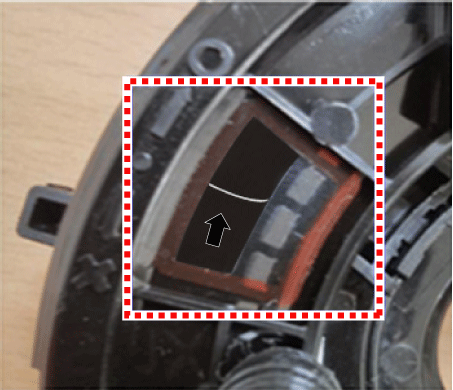
|

| White cable is visible through 10 O' Clock Neutral Check Window
| White cable is not visible through 10 O' Clock Neutral Check Window
|
|
| 4. | Clock spring manual neutral setting procedure. | (1) | Press the Auto Lock at 6 O' Clock and turn clockwise 3 rotations. 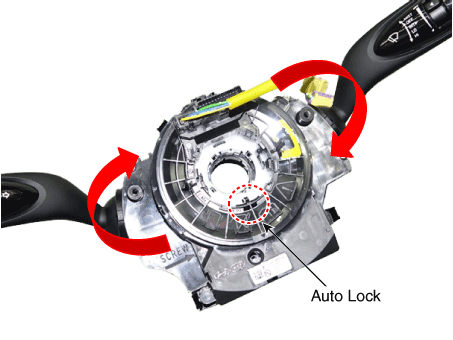
|
| (2) | Press the Auto Lock at 6 O' Clock and turn counter-clockwise 3 rotations. |
| (3) | If white cable is visible through the 5 O' Clock Neutral Check Window, then the spring is set to neutral. 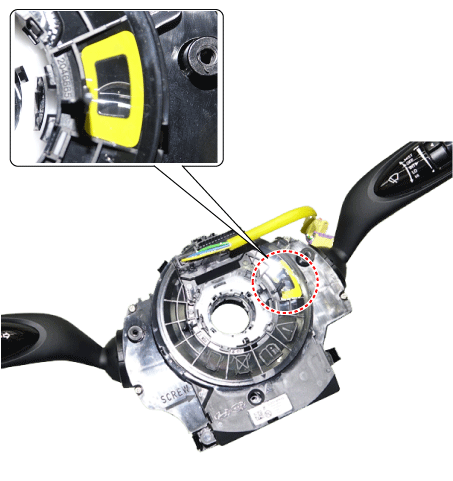
|
|
| 5. | Connect the clock spring wiring harness connector and horn wiring harness connector in the clock spring. |
| 6. | Insert steering column shroud and install the mounting screw. |
| 7. | Install the steering wheel. (Refer to Steering System - "Steering Wheel") |
| 8. | Install the airbag module. |
| 9. | Reconnect the battery negative (-) terminal. |
| 10. | After installing the airbag, confirm proper airbag system and horn operation. | •
| Turn the ignition switch ON the airbag warning lamp should be turned on for about 6 seconds and then go off. |
|
|
Passenger Airbag (PAB) Module
Description and operation
The passenger airbag (PAB) is installed inside the crash pad and protects the front passenger in the event of a frontal crash. The SRSCM determines if and when to deploy the PAB.
| •
| Never attempt to measure the circuit resistance of the airbag module (squib) even if you are using a specified tester. If the circuit resistance is measured with a tester, accidental airbag deployment will result in serious personal injury. |
|
Components and components location
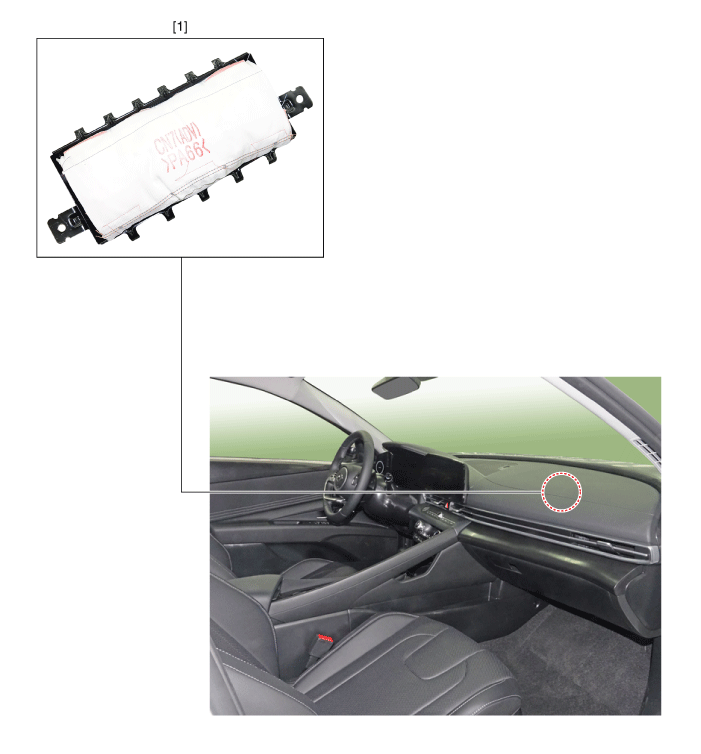
1. Passenger airbag (PAB)
|
|
Repair procedures
| 1. | Disconnect the negative (-) battery terminal. | •
| Disconnect the battery negative cable, and wait for at least three minutes before beginning work. |
|
|
| 2. | Remove the main crash pad assembly. (Refer to Body (Interior and Exterior) - "Main Crash Pad Assembly") |
| 3. | Loosen the passenger airbag mounting nuts (A). 
|
| 4. | Disconnect the PAB module connector (A). 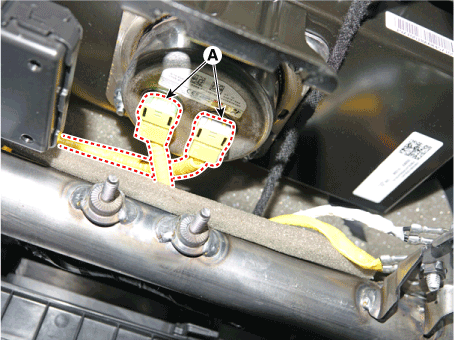
|
| 5. | Remove the PAB module (A) after loosening the mounting bolts. 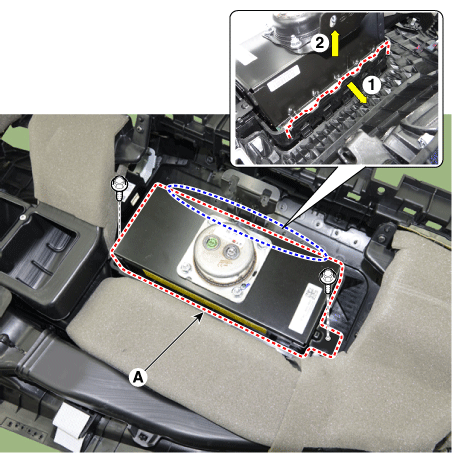
| •
| If the crash pad is damaged by the passenger's airbag deployment, replace the crash pad at the same time. |
|
| •
| The removed airbag module is placed with the airbag cover side facing up. |
|
|
| 1. | Check if the battery (-) cable is disconnected. | •
| Disconnect the battery negative cable, and wait for at least three minutes before beginning work. |
|
|
| 2. | Place a passenger airbag (A) on the crash pad and tighten the passenger airbag mounting bolts. Tightening torque : 3.9 - 5.9 N.m (0.4 - 0.6 kgf.m, 2.9 - 4.3 lb-ft) |
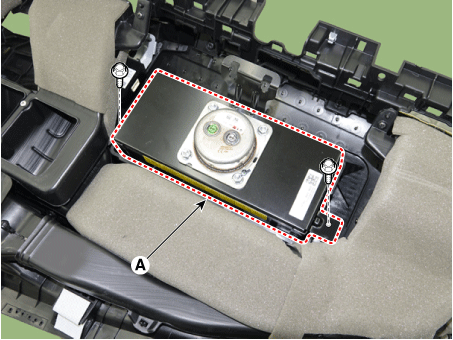
|
| 3. | Install the main crash pad assembly. (Refer to Body (Interior and Exterior) - "Main Crash Pad Assembly") |
| 4. | Connect the PAB module connector (A). 
|
| 5. | Tighten the passenger airbag mounting nuts (A). Tightening torque : 3.9 - 5.9 N.m (0.4 - 0.6 kgf.m, 2.9 - 4.3 lb-ft) |

|
| 6. | Reconnect the battery negative (-) terminal. |
| 7. | After installing the passenger airbag, confirm proper system operation. | •
| Turn the ignition switch ON the airbag warning lamp should be turned on for about 6 seconds and then go off. |
|
|
Side Airbag (SAB) Module
Description and operation
The Side Airbags (SAB) are installed inside the front seat and protects the driver and passenger from danger when a side crash occurs. The SRSCM determines deployment of the side airbag by using the Side Impact Sensor (SIS) signal.
| •
| Never attempt to measure the circuit resistance of the airbag module (squib) even if you are using a specified tester. If the circuit resistance is measured with a tester, accidental airbag deployment will result in serious personal injury. |
|
Components and components location
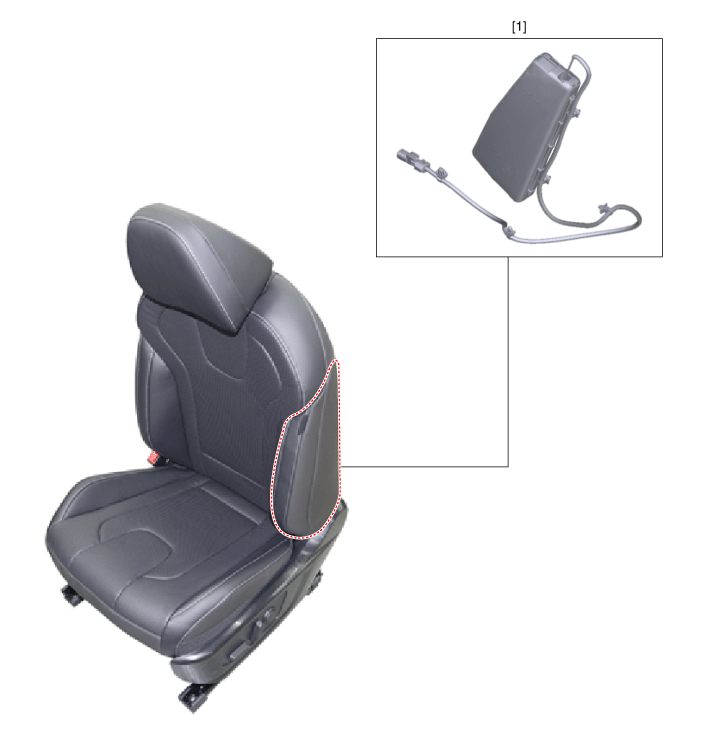
Repair procedures
| 1. | Disconnect the negative (-) battery terminal. | •
| Disconnect the battery negative cable, and wait for at least three minutes before beginning work. |
|
|
| 2. | Remove the front seat assembly. (Refer to Body (Interior and Exterior) - "Front Seat Assembly") |
| 3. | Remove the seat back cover. (Refer to Body (Interior and Exterior) - "Front Seat Back Cover") | •
| When the front side airbag has deployed after a collision, replace the seat back as an assembly. |
|
|
| 4. | Remove the side airbag (B) after loosening the mounting nuts (A). 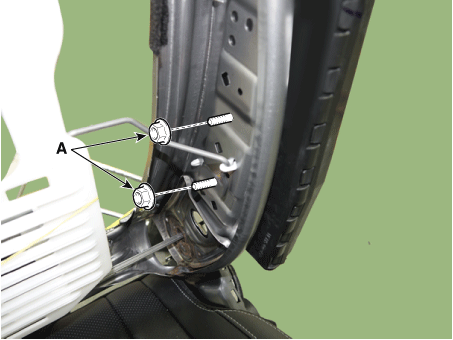
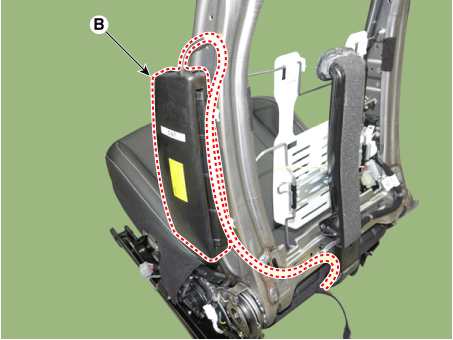
|
| 1. | Check if the battery (-) cable is disconnected. | •
| Disconnect the battery negative cable, and wait for at least three minutes before beginning work. |
|
|
| 2. | Install the SAB. Tightening torque : 5.9 - 7.8 N.m (0.6 - 0.8 kgf.m, 2.9 - 5.8 lb-ft) |
|
| 3. | Install a new seat back cover. (Refer to Body (Interior and Exterior) - "Front Seat Back Cover") | •
| Make sure that the airbag assembly cover is installed properly. Improper installation may prevent a proper deployment. |
|
|
| 4. | Install a front seat assembly. (Refer to Body (Interior and Exterior) - "Front Seat Assembly") |
| 5. | Recline and slide the front seat forward fully, make sure the harness wires are not pinched or interfered by other parts. |
| 6. | Reconnect the negative (-) battery terminal. |
| 7. | After installing the side airbag, confirm proper system operation. | •
| Turn the ignition switch ON the airbag warning lamp should be turned on for about 6 seconds and then go off. |
|
|
Curtain Airbag (CAB) Module
Description and operation
Curtain airbags are installed inside the headliner (LH and RH) and protect the driver and passenger from danger when a side crash occurs. The SRSCM determines deployment of the curtain airbag by using the side impact sensor (SIS) signal.
Components and components location
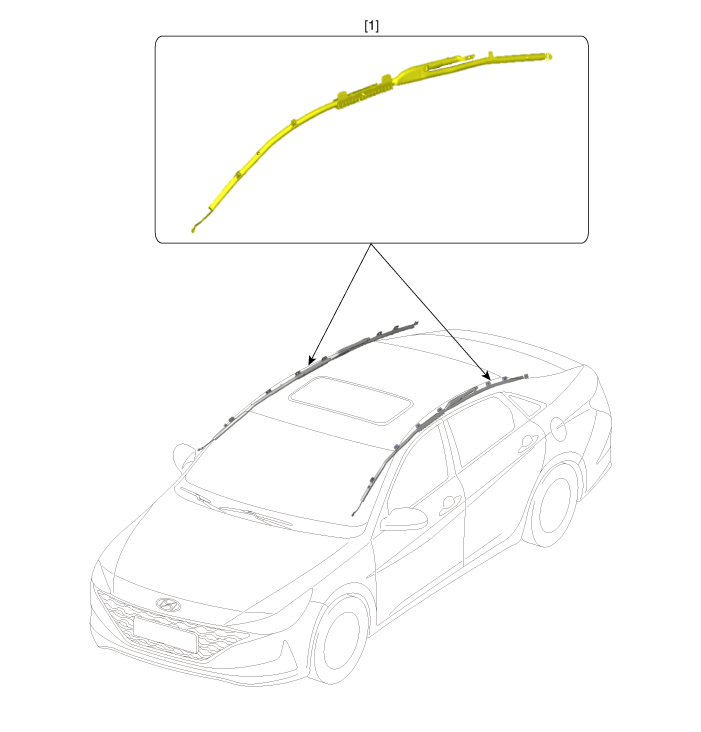
Repair procedures
| 1. | Disconnect the negative (-) battery terminal. | •
| Disconnect the battery negative cable, and wait for at least three minutes before beginning work. |
|
|
| 2. | Remove the roof trim assembly. (Refer to Body (Interior and Exterior) - "Roof Trim Assembly") |
| 3. | Disconnect the curtain airbag module connector (A). 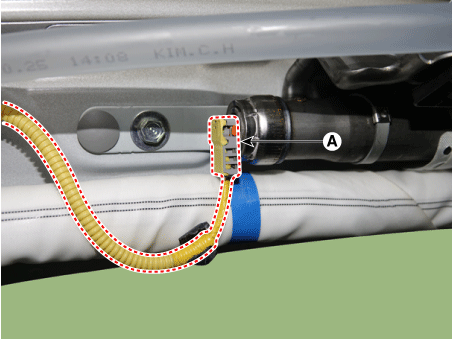
|
| 4. | Remove the curtain airbag module (A) after loosening the mounting bolts. 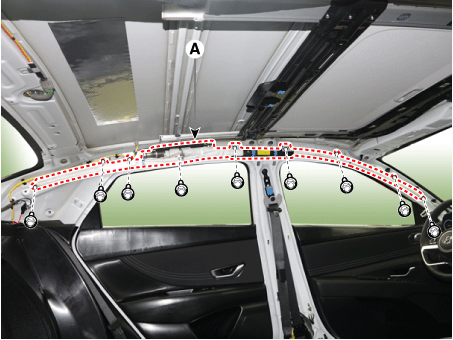
|
| 1. | Check if the battery (-) cable is disconnected. | •
| Disconnect the battery negative cable, and wait for at least three minutes before beginning work. |
|
|
| 2. | Place a curtain airbag module and tighten the mounting bolts. Tightening torque : Bolt : 7.8 - 11.8 N.m (0.8 - 1.2 kgf.m, 5.8 - 8.7 lb-ft) |
| •
| The left and right curtain airbags are identified by the color of the tape and warning sticker on the module as follows. |
| –
| Left side : red tape (yellow : warning sticker) |
| –
| Right side : blue tape (orange : warning sticker) |
|
| •
| Never twist the airbag module when installing it. If the module is twisted, the airbag module may operate abnormally. |
|
|
| 3. | Connect the curtain airbag connector. |
| 4. | Install the roof trim assembly. (Refer to Body (Interior and Exterior) - "Roof Trim Assembly") |
| 5. | Reconnect the negative (-) battery terminal. |
| 6. | After installing the curtain airbag (CAB), confirm proper system operation. | •
| Turn the ignition switch ON the airbag warning lamp should be turned on for about 6 seconds and then go off. |
|
|
Airbag Module Disposal
Description and operation
When you scrap a vehicle equipped with an airbag, you must deploy it first.
When you deploy an airbag, you need to have a skilled mechanic do the work. The used airbag should not be reinstalled in another vehicle for reuse.
| •
| Upon deployment, the explosion will create a loud noise, so you have to do it in a proper place not to disturb others. |
| •
| When you deploy an airbag, use a specially designated tool and select a place where there is no electric noise. |
| •
| When operating the airbag deployment tool, you must be at least 5 meters away from the airbag. |
| •
| Upon deployment, the airbag gives off an intense heat. So wait for 30 minutes or so before touching it. |
| •
| Make sure to use gloves and safety goggles when you deal with the deployed airbag. |
| •
| Do not spread water over the deployed airbag. |
| •
| Always wash your hands after the deployment work is completed. |
|
Deploying Airbags in the Vehicle
| 1. | Turn the ignition switch OFF, and disconnect the battery negative cable and wait at least three minutes. |
| 2. | Confirm that each airbag or side airbag is securely mounted. |
| 3. | Confirm that the special tool is functioning properly by following the check procedure. | (1) | Disconnect the 2P connector between the airbag and wire harness. |
| (2) | Install the SST | •
| For the driver airbag, separate the 2-pin connector from it and connect the deployment adapter to reattach it on the steering wheel. |
|
|
| 4. | Locate the airbag deployment tool at a place at least 5 meters away from the airbag. |
| 5. | After connecting the deployment adapter with the deployment tool (0957A-34100A), connect it to the external battery for deployment. | (2) | Deployment tool (0957A-34100A) |
| (3) | Deployment adapter | –
| DAB, PAB, CAB, BPT (0957A-AL140) |
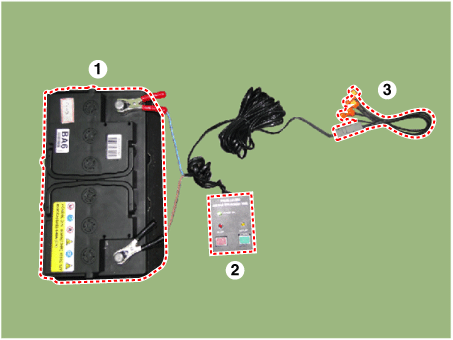
|
|
| 6. | Switch on the deployment tool to proceed with deployment. | (1) | If the battery is connected, the POWER ON (1) light will be on. |
| (2) | Press and hold READY (2) until it is on, and then press DEPLOY (3) to deploy the airbag. 
| •
| Upon deployment, the airbag will create a loud noise and you can see it suddenly expand and contract slowly. |
|
|
|
| 7. | Dispose of the complete airbag. No parts can be reused. Place it in a sturdy plastic bag and seal it securely. 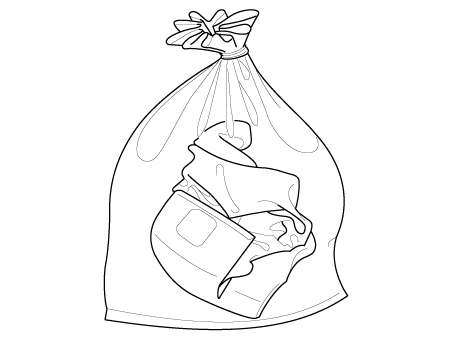
|
Deploying the Airbag Out of the Vehicle
In case the airbag is separated from a scrapped car, or when you find defects or damages on it, you have to deploy it as follows :
| 1. | Place the airbag deployment module face upward on a flat surface outdoor. | •
| If the airbag deployment module were face downward, the airbag will pop up and cause damage to people around it. |
|
|
| 2. | Get ready to deploy the airbag as follows: | (1) | Separate the 2-pin connecter of the airbag from the vehicle. |
| (2) | Connect the deployment adapter. | •
| For the driver airbag, separate the 2-pin connector from it and connect the deployment adapter to reattach it on the steering wheel. |
|
|
| 3. | Locate the airbag deployment tool at a place at least 5 meters away from the airbag. |
| 4. | After connecting the deployment adapter (0957A-AL140, 0957A-AL150, 0957A-AL160) with the deployment tool (0957A-34100A), connect it to the external battery (12V) for deployment. | (2) | Airbag Deploy (0957A-34100A) |
| (3) | Deployment adapter | –
| DAB, PAB, CAB, BPT (0957A-AL140) |

| •
| When EFD are deployed, broken parts are exploded and scattered. |
| •
| EFD (Emergency Fastening Device) must be placed in the piled up 5 tires to avoid exploded broken parts. |
| •
| Technicians should wear an eye protector and extremely be cautions of exploded broken parts. |
|
|
|
| 5. | Switch on the deployment tool to proceed with deployment. | (1) | If the battery is connected, the POWER ON (1) light will be on. |
| (2) | Press and hold READY (2) until it is on, and then press DEPLOY (3) to deploy the airbag. 
|
|
| 6. | Dispose of the complete airbag. No parts can be reused. Place it in a sturdy plastic bag and seal it securely. 
|
Disposal of Damaged Airbag (Not Deployed Airbag)
| 1. | Turn the ignition switch OFF, and disconnect the battery negative cable and wait at least three minutes. |
| 2. | If installed airbags in a vehicle, follow the removal procedure of damaged airbag. |
| 3. | If the removed parts have a lead wire, make a short circuit by twisting together the two airbag inflator wires. |
| 4. | Package the airbag in exactly the same packing that the new replacement part come in. |
| 5. | Mark the outside of the box ''DAMAGED AIRBAG NOT DEPLOYED'' so it does not get confused with your parts stock. |
Components and components location
Components1. Front impact sensor (FIS)2. Supplemental Restraint System Control Module (SRSCM)3. Front impact sensor (FIS)4. Gravity side Impact Sensor (G-SIS)5. P ...
Description and operation
DescriptionThe Seat Belt Pretensioners (BPT) are installed inside center pillar (LH & RH). When a vehicle crashes with a certain degree of frontal impact, the pretensi ...
 Hyundai Elantra CN7: Airbag Module
Hyundai Elantra CN7: Airbag Module




































